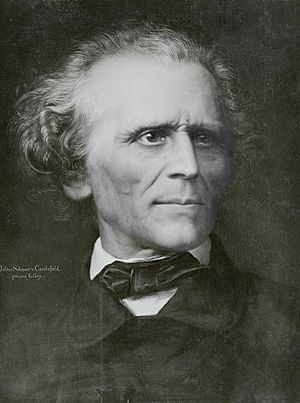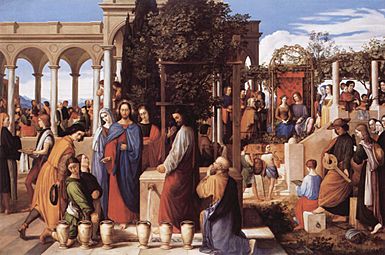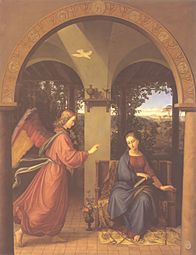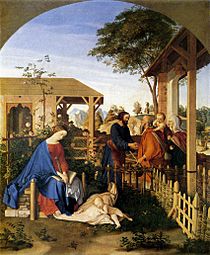Julius Schnorr von Carolsfeld facts for kids
Quick facts for kids
Julius Schnorr von Carolsfeld
|
|
|---|---|
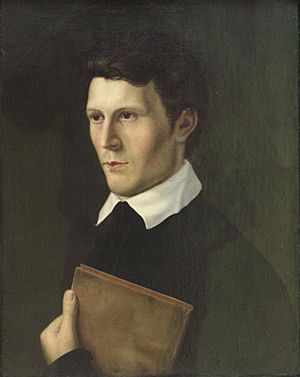
Portrait of Von Carolsfeld as a young man (1820), by Friedrich von Olivier, Albertinum
|
|
| Born | 26 March 1794 |
| Died | 24 May 1872 (aged 78) Munich, Kingdom of Bavaria, German Empire
|
| Occupation | Painter |
Julius Schnorr von Carolsfeld (born March 26, 1794 – died May 24, 1872) was a German painter. He is known mostly for his paintings about stories from the Bible. When he was young, he joined a group of artists called the Nazarene movement. They wanted to bring back an older, more detailed style of religious art, like the Renaissance artists used.
He is famous for his big Picture Bible with many illustrations. He also designed beautiful stained glass windows for churches.
Contents
About Julius Schnorr von Carolsfeld
Julius Schnorr von Carolsfeld was born in Leipzig, Germany. His father, Veit Hanns Schnorr von Carolsfeld, was also an artist. He was a draughtsman, engraver, and painter. Julius learned a lot about art from his father when he was young.
In 1811, Julius went to the Vienna Academy to study art. Some artists had recently left this school because they did not like the old-fashioned teaching style. Julius became friends with other artists there, like Joseph Anton Koch. They helped shape his painting style.
Joining the Nazarene Movement
In 1815, Schnorr moved to Rome, Italy. There, he joined the Nazarene movement. This group of artists focused on religious and romantic art. They wanted to return to the art styles of earlier times, especially the Renaissance. They did not like the newer art styles of their own time.
When he first arrived in Rome, Schnorr studied paintings from the 1400s. He especially liked the simple style of Fra Angelico. But soon, he started to look at more detailed and grander art from the High Renaissance.
Fresco Painting and Family Life
The Nazarene artists wanted to bring back fresco painting. Fresco painting is a way of painting directly onto wet plaster walls. Schnorr got a chance to show his skills when he was asked to decorate a large house called the Villa Massimo in Rome. He painted frescoes there that showed stories from a famous poem by Ariosto. Other artists, like Peter von Cornelius, also painted frescoes in the house.
In 1827, Schnorr married Maria Heller. His son, Ludwig Schnorr von Carolsfeld, became a famous opera singer. Sadly, Ludwig died at only 29 years old. He was just starting to become well-known for singing in Wagner's opera Tristan und Isolde. Julius's brother, Ludwig Ferdinand, was also a painter. Julius Schnorr von Carolsfeld died in Munich in 1872.
Julius Schnorr's Art Career
In 1825, Schnorr left Rome and moved to Munich, Germany. This was a new period for his art. He started working for Ludwig I of Bavaria, who was the king. Schnorr brought the wall-painting skills he learned in Italy to Germany.
He became a special artist for the Bavarian court. He organized a team of painters. Together, they painted five large halls in the new palace, called the "Residenz." These paintings showed scenes from the German epic poem, the Nibelungenlied. He also painted stories about famous German leaders like Charlemagne and Frederick Barbarossa.
Schnorr had wanted to combine these German history paintings with scenes from the Old Testament. However, King Ludwig did not agree to this idea. Schnorr felt that he was just painting "a newspaper report of the Middle Ages." Some art experts thought his paintings were creative and well-drawn. But they also felt they were sometimes too much in their ideas and style.
In 1846, Schnorr moved to Dresden. He became a professor at the art academy there. The next year, he was made the director of the Gemäldegalerie, which is a famous art gallery.
Schnorr's Famous Artworks
Schnorr's later work focused on biblical illustrations. He was a Lutheran and had a broad view of religion. His most famous work is the Picture Bible. It was published in 30 parts between 1852 and 1860. An English version came out in 1861.
The illustrations in the Picture Bible were often very detailed and had many things happening. Some art experts thought they were not as simple or balanced as earlier works by artists like Raphael. Schnorr's style was more detailed and grand, like the later Renaissance art.
Stained Glass Designs
Schnorr's biblical drawings also led him to design church windows. He became well-known in Germany and received requests for designs from Great Britain. He was one of ten artists who designed stained-glass windows for Glasgow Cathedral in Scotland in 1856–57. These windows were made in a royal factory in Munich.
Later, he designed windows for St Paul's Cathedral in London. However, these Munich-made glass windows caused some debate. Some people who liked medieval art thought they lacked brightness. They called them "coloured blinds." But others liked these modern windows. They said the windows combined the good drawing of early Italian oil paintings with the colors of 16th-century glass.
Four of Schnorr's windows were put in St Paul's Cathedral. Three were later removed in 1888, and one was destroyed in 1941. Most of the Munich glass at Glasgow Cathedral was also removed during the 1900s.
Paintings
-
Annunciation (1820)
-
Madonna and Child (1820)
Art Returned After World War II
In August 2016, a drawing by Schnorr called A Branch with Shriveled Leaves (1817) was returned. This drawing was in the collection of the National Gallery of Art in Washington, D.C. It was given back to the family of Marianne Schmidl. She was an Austrian ethnologist who was killed during the Holocaust.
See also
 In Spanish: Julius Schnorr von Carolsfeld para niños
In Spanish: Julius Schnorr von Carolsfeld para niños


